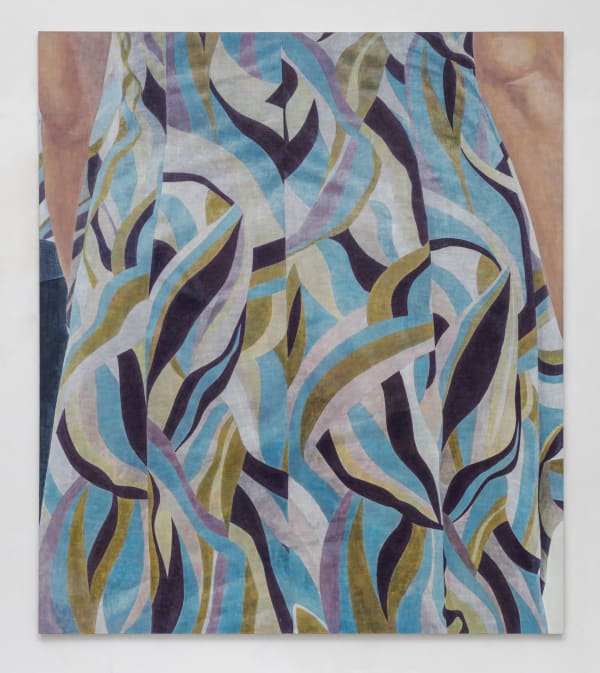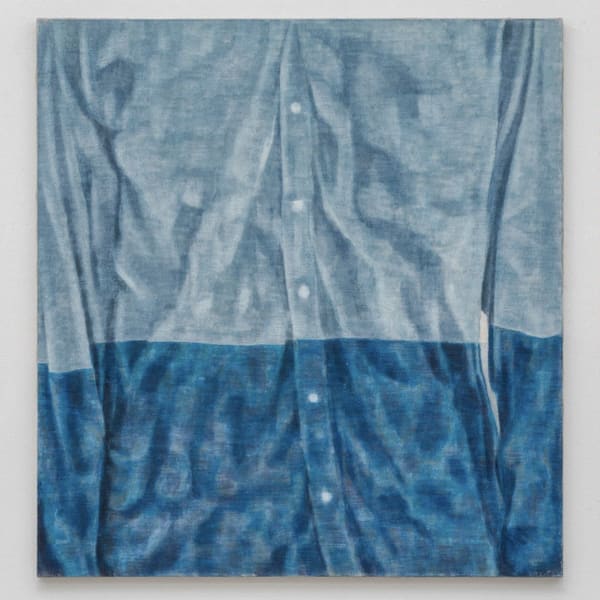Kang Seok Ho: Deep is the rising sun, far is the falling one
Tina Kim Gallery is pleased to announce Deep is the rising sun, far is the falling one, the first New York solo exhibition of Kang Seok Ho (1971-2021). Upon receiving his Bachelors of Fine Art in sculpture at Seoul National University, Kang Seok Ho left for Germany to study with Jan Dibbets (b. 1941) at the Kunstakademie Düsseldorf, where he received his Masters of Fine Art in painting. Kang Seok Ho is an artist who investigates and probes the medium of painting through the simple and everyday premise around the act of “seeing.” For example, in his 2006 solo exhibition at Kumho Museum of Art in Seoul, he exhibited over forty paintings that repeatedly depicted an image taken from a photograph showing the backside of someone wearing a checkered green jacket with their hands clasped behind them. For Kang, painting begins with an interior meditation on the question of how to approach and portray subject matter, rather than a question regarding its content.
When Kang returned to Korea in the early 2000s, the Korean art scene at that time was defined by a multimedia, postmodern, socio-political aesthetic, leaning heavily into a post-genre and post-medium “anything goes” tendency.[1] Kang Seok Ho did not pay attention to nor become wrapped up in this mindset. Despite the advent of digital cameras and the overflow and saturation of digital images, Kang chose to focus on examining the relationship between the image and the act of its portrayal, and how to widen the distance between those two entities. Through admiring the attitudes of masters such as Piero della Francesca, Giorgione, Tintoretto, Titian, and Giorgio Morandi, Kang independently explored more traditional subject matter such as figurative, landscape, and still-life paintings, as well as other themes involving time and space.
This exhibition focuses on Kang’s “Get Up” series, which marks Kang’s investigations in painting that first began in Germany and continued until his untimely death in 2021. Initially prompted by a drawing Kang did in 1999 of his friend’s sweater while sitting across from each other at a cafe, these works are based on photos Kang took, then cut, re-angled, and enlarged on the canvas. Kang excluded narrative features such as a person’s face and the surrounding background, and focused rather on formal details such as color, pattern, texture, and wrinkles of fabric as they move along the curves of the body, creating a unique visual language. In the “Get Up” series, which previously focused on depicting the figure’s frontal side, Kang started to deal with the back of the figure after the year 2000. Inspired by the actors sitting with their backs to the camera in the film of Michelangelo Antonioni, Kang Seok Ho felt a strange and unfamiliar discomfort that he simultaneously alleviated and revealed in the pictorial realm, finding this to be an interesting subject matter. The back of a woman with long curly hair reminiscent of a waterfall in a valley, or the focus on depicting color and texture of fabric like a “dry bamboo leaf” all reveal Kang’s attitude that closely mimics the philosophy of traditional Asian landscape painters. In reference to his own paintings of white trousers and denim pants, he has alluded to white porcelain or rocky landscapes, meaning that he thought of his work as being closer to landscape rather than portraiture.[2] Furthermore, Kang Seok Ho placed great emphasis on the methodologies involving surface preparation as well as brushwork. When considering the absorbency of paint, he was particular about the type of linen he used, and he devised a method of layering thinned paint several times on the surface. The brush strokes serve to reveal and resemble the weaving and materiality of the canvas more than showing the colors or shapes depicted on it. On the canvas where one encounters the physicality of his brushstrokes pressed and rubbed with color, representation and description feel far from his intent. While Kang’s work may fit into the category of realism, the sense of transparency where light and air seems to flow and move without constraint is emblematic of Kang’s distinct aesthetic and his sense of lyricism in the everyday.
The artist’s research on the act of seeing is further revealed in his series of drapes. While drapes are usually hung over windows covering the view, they also become stand in’s, replacing the outside scenery. The drapes that the artist looks at form a horizon line along the simple color, pattern, and fabric of the canvas, transforming into the image itself. An image that does not seem to convey a direct message ultimately leads the viewer to keep returning to it, pondering the painting and the artist’s vision. In the case of his “Couple Series,” which shows a close-up of one eye from two people, it is the image that looks at the viewer, simultaneously interrogating and responding to them. In addition, his black and white “Gesture” series captures the gestures of politicians and athletes exposed to the media. His “Nude” series focuses on various skin tones and textures, as well as a still life study of stationary objects, and builds up to his “Cube” series. Kang Seok Ho’s representative painting series are all an attempt to experiment with and discover a new approach to the unique structure and confines of the genre of painting.
The title of this exhibition “Deep is the rising sun, far is the falling one” was the subtitle of Kang Seok Ho’s essay “The Second Hiking.”[3] The descriptions of his daily climbing route of Namsan Mountain, where the traces of soil are neatly swept and the colors of the light and sunset shine through the pine trees and the forest, are not too different from the experience of viewing Kang’s paintings. Since Kang Seok Ho’s attitude towards the everyday is inextricably linked to the aesthetic characteristic of his paintings, his writings that record his daily life serve as an important foundation for understanding his inner world.[4]
ABOUT THE ARTIST
Kang Seok Ho received his Bachelors of Fine Art in sculpture at Seoul National University, then left for Germany to study with Jan Dibbets (b. 1941) at the Kunstakademie Düsseldorf, where he received his Masters of Fine Art in painting. After winning the UBS Art Award in Basel, Switzerland in 2000, he returned to Korea and won the Seoknam Art Prize (Seoul, Korea) in 2004, and he was the selected artist for “2008 Young Korean Artist: I AM AN ARTIST” by the National Museum of Modern and Contemporary Art. From 2003 to 2020, he held 16 solo exhibitions at Insa Art Space, Kumho Museum of Art, Mimesis Art Museum, etc., and passed away in an unexpected accident in 2021. Beyond his artistic practice, he was also a furniture collector and curator. In 2008, he organized a number of exhibitions, including “Utopia, From Ideal to Reality” at the Kumho Museum of Art and “Those who see this also think of it” at Art Space 3. Not separating his daily life and art, he led meetings to interact with fellow artists on the subjects of painting, books, music, hiking, and fishing. He taught as a professor at Seoul National University of Science and Technology from 2018 to 2021, and his first retrospective, “seok ho kang: Three Minute Delight” (2022-2023) was held at the Seoul Museum of Art in the first year after his death.
—
[1] Su Mi Kang, “Politics of Korean Art in the 2000s: Performing Violation Where Anything is Possible,” Post 1990s New Political Art: The Rebels Now/Here, Academic Seminar Presentation (2009, Gyeonggi-Do Art Museum).
[2] Interview with Kang Seok Ho, Kang Seok Ho, Solo Exhibition Brochure (2012, 16 bungee, Seoul).
[3] Kang Seok Ho, “The Second Hiking,” Three Minute Delight, Mimesis, 2023, Page 97.
[4] Eunju Lee, “Kang Seok Ho’s Silent Paintings and Three Minute Delight,” Three Minute Delight, Mimesis, 2023, Page 240.
-

Kang Seok Ho’s Never-Ending Act of Slow Looking
Hyperallergic August 8, 2023The colorful geometric print of a dress, distorted by darting; the body underneath a loose-fitting, plaid button-down obscured in the billowing fabric; a sternly patterned...Learn More -

Kang Seok Ho: Deep is the rising sun, far is the falling one
Brooklyn Rail July 13, 2023In a solo exhibition currently at Tina Kim Gallery, fifteen paintings by Kang Seok Ho often zoom in to a detail of a person’s clothing,...Learn More

